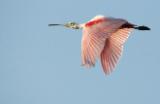Climate Change and J.N. "Ding" Darling NWR by Defenders of Wildlife
The seagrass beds, mangrove islands and hardwood hammocks of the J.N. "Ding" Darling National Wildlife Refuge sustain an incredible diversity of wildlife in the Gulf of Mexico. This barrier island refuge is a birding mecca, drawing people from all over the world. It is also a haven for the threatened loggerhead turtle and endangered manatee and American crocodile.
The Threat
The tides, salinity, and estuarine nutrient exchange on which almost all of the refuge's plants and wildlife depend, are beginning to show the effects of global warming. Rising seas have begun eating away at the beaches and barrier islands that protect Ding Darling's coastal manatee habitat. If the erosion continues, this habitat will gradually disappear. Toxic algal blooms, such as the red tide that killed more than 150 manatees in 1996, thrive in warmer waters and are becoming more common.
Rising temperatures have also been linked to a higher incidence of female hatchlings in Florida loggerhead turtle populations. Higher temperatures during incubation favor the development of females. With temperatures projected to go even higher, male loggerheads could become scarce.
Unlike adults, juvenile American crocodiles lack the ability to maintain their own optimal internal fresh water content, making them more susceptible to growth and survival problems as water salinity increases. Reduced freshwater flow into mangrove estuaries has resulted in saltier mangroves, less freshwater available to juveniles and reduced numbers of American alligators.







